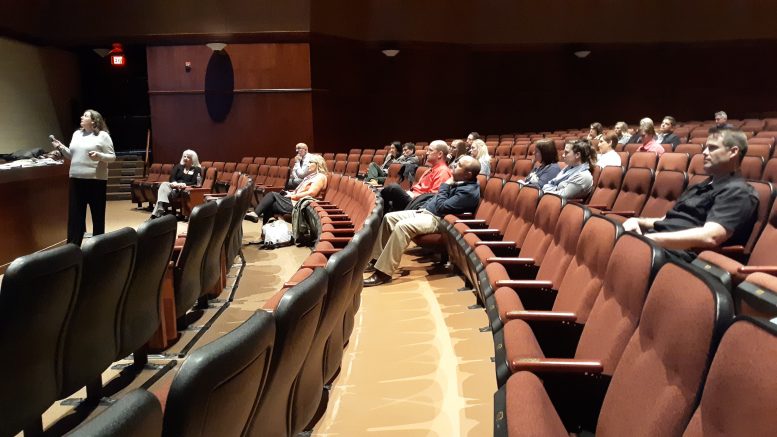By JAN LARSON McLAUGHLIN
BG Independent News
Normally a place of musical performances and proud parents, Bowling Green City School’s Performing Arts Center was a place of uncomfortable quiet and anxious parents Monday evening. Nearly 60 parents and school staff gathered in the hushed auditorium in search of answers about suicide.
The district offers regular discussions on the topic for students, but this was for their parents – trying to understand the loss of 16-year-old Eric Baer, who took his life earlier this month.
The parents were seeking answers on how to help their own children deal with the loss, and how to reach out to the family of the young boy.
And they were wanting to know the clues to look for in their own children who might be contemplating suicide.
“In light of this, we wanted to do something more,” for the parents, Superintendent Francis Scruci said. “If we can make a difference in even one kid’s life.”
Counselors from Children’s Resource Center, Ann Huss and Noelle Duvall, shared information specific to adolescent suicides. Approximately 25 percent of adolescents consider suicide. “That’s one whole grade,” in a high school, Huss said.
Suicide is the second leading cause of death in ages 10 to 24, and first for deaths in ages 10 to 15.
Up to 90 percent of adolescents who complete suicide have at least one mental health issue – the most common being depression. One in eight teenagers experience depression.
Some of the more common symptoms of depression include weight loss or gain, sleep problems, exhaustion, sad moods, loss of interest, irritability, inability to concentrate, negative thinking, and withdrawal from friends and family.
“When it comes to students, it’s probably going to be their peers who see these differences first,” Huss said.
Parents should not brush off moody behavior or lack of good judgment from their teens.
“Sometimes that gets overlooked,” Huss said. “You need to really listen at the present moment when you sit them down and talk with them.”
Parents should not ignore teens who are consistently bored, irritated, stop taking care of their personal hygiene, don’t do homework, make statements like “I hate my life,” or are either moping or highly agitated, Huss said. They may see changes in the teen’s appetite, lack of concentration, and disinterest in everything.
Therapy and medication have proven to be effective treatments for depression. But the sooner parents catch it, the better, Huss said.
Protective factors such as supportive relationships, religious beliefs, good grades, good impulse control, difficulty accessing a method for suicide, and responsibilities to others all work to reduce the chances of suicide.
The risk factors that increase those chances include a family history of suicide, a significant loss faced by the teen, social isolation, being labled as different such as being LGBTQ, or having access to a firearm, “since it’s a much more lethal method,” Duvall said.
The biggest risk is being depressed. “It’s really important to get help so that can be addressed,” Duvall said.
The second biggest risk is substance abuse, which impacts decision making.
In some cases, there are signs. There may be blatant verbal warnings, like “I wish I was dead,” or indirect warnings like “You’d be better off without me.”
A teen may increase abusing drugs or alcohol, and may experiment with risky behavior like jumping from high places or cut themselves. They may suddenly become happy and give away possessions, if they have made the decision to try suicide.
And 80 percent of kids who take their lives talked about it prior to doing so.
Duvall also addressed the myths of suicide:
- Talking about suicide is going to make somebody think about doing it.
- A person who threatens is seeking attention, and won’t follow through.
- Only crazy people take their lives. “We really need to get past that, so people feel comfortable getting help,” Duvall said.
- No one you know would do that. Suicide is an “equal opportunity killer,” Duvall said.
- Suicide is a city problem. Actually, rural areas have higher suicide rates.
- Once a person decides on suicide, they can’t be stopped. “You can’t see the way out yourself,” but others can help, Duvall said.
While depression is a medical condition, suicide is a crisis. It requires that adults acknowledge the problem, let the child know they are cared about, and tell someone who can help.
Duvall listed off what parents should do if they feel a child is considering suicide. That includes talk openly, instill hope and stay calm. She recalled one child sharing her experience after opening up to her mom. “My mom really freaked out, so I knew I shouldn’t talk about it.”
Duvall also listed the “don’ts” for parents, like don’t make moral judgments, don’t encourage guilt, don’t offer empty reassurances such as “you’re luckier than most people,” don’t minimize the problem by suggesting it will be all better after a good night’s sleep, and don’t leave the child alone.
Help can be found with school counselors, pediatricians, mental health agencies, the hospital emergency department, or church. Immediate help is available 24/7 at Children’s Resource Center by calling 888-466-5437, or for adults at Unison Health at 419-502-4673.
“The important thing is to reach out to someone,” Duvall said.
Because of the recent loss of a high school classmate, Huss and Duvall added another part to their presentation on how to help adolescents going through the grieving process.
“There’s no right way to behave after a sudden death,” Huss stressed. “Grieving is a process. It’s going to take time and we all do it differently.”
Teens need to know it’s normal to feel shock, fear and sadness. Parents should not try to cheer up a grieving teen, and should reassure them that they are not at fault.
“No one’s to blame if there’s a suicide,” Huss said. “Many times it happens and there were no signs. It was nothing they missed.”
Duvall cautioned that bereavement after a suicide may take longer. Survivors are often burdened with thoughts of “if I had only done this…”
“They are not responsible for what happened,” Duvall said.
Several parents at Monday’s meeting had questions for the CRC counselors.
One woman said her daughter was a friend of the boy who took his life. “I can’t get her to talk about it.”
All she will say to her mom was that “we were joking around Friday. Everything seemed great. It doesn’t make sense.”
The counselors suggested giving her plenty of opportunities to talk, or express herself through art, poetry or music.
One parent said another boy had confided in her son that he was having thoughts about suicide. The CRC counselors said that information should be shared with a school counselor, and that her son should not view it as a betrayal to his friend.
“It’s really important that an adult knows,” Duvall said.
Another parent asked if the school district responds to “red flags” from students. School staff in the audience assured that they work together to address those concerns and connect the student with the help needed.
Scruci said that earlier in the day, a parent was told her child in elementary school was talking about suicide. “The parent would not take it seriously,” he said.
The counselors said CRC staff will meet with the parent and child at school if that would be helpful.
“You need to take it seriously everytime they talk about it,” Huss said.
A mom asked how to reach out to the family of the student who died.
“I think many of us are at a loss of what to do,” she said.
Because of the stigma surrounding suicide, some adults don’t know how to support the family left behind. “People kind of pull back because they don’t know what to say,” Duvall said.
Huss suggested that people treat the grieving family the same way they would other families who suffered the loss of a loved one. Drop off food, offer condolences, and provide a shoulder to cry on.
A woman whose sister took her own life, talked about the impact on their mother. “Let them talk, and let them know you are there,” she said. “It’s the worst way to lose a child.”
One asked how children, with limited vocabularies, can express their feelings about a suicide – when so many adults are unable to do so. The counselors suggested prompting the child to express feelings through art or music.
Another asked about the correlation between bullying and suicide. While the school district works to prevent bullying, the counselors said social media is often the source.
“We can’t do it alone, and neither can you,” Scruci said to the parents as the meeting ended. “We’ve got to have a two-way street with communication. We’re here for you.”




